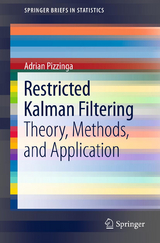Restricted Kalman Filtering
Theory, Methods, and Application
Seiten
2012
Springer-Verlag New York Inc.
978-1-4614-4737-5 (ISBN)
Springer-Verlag New York Inc.
978-1-4614-4737-5 (ISBN)
In statistics, the Kalman filter is a mathematical method whose purpose is to use a series of measurements observed over time, containing random variations and other inaccuracies, and produce estimates that tend to be closer to the true unknown values than those that would be based on a single measurement alone.
In statistics, the Kalman filter is a mathematical method whose purpose is to use a series of measurements observed over time, containing random variations and other inaccuracies, and produce estimates that tend to be closer to the true unknown values than those that would be based on a single measurement alone. This Brief offers developments on Kalman filtering subject to general linear constraints. There are essentially three types of contributions: new proofs for results already established; new results within the subject; and applications in investment analysis and macroeconomics, where the proposed methods are illustrated and evaluated. The Brief has a short chapter on linear state space models and the Kalman filter, aiming to make the book self-contained and to give a quick reference to the reader (notation and terminology). The prerequisites would be a contact with time series analysis in the level of Hamilton (1994) or Brockwell & Davis (2002) and also with linear state models and the Kalman filter – each of these books has a chapter entirely dedicated to the subject. The book is intended for graduate students, researchers and practitioners in statistics (specifically: time series analysis and econometrics).
In statistics, the Kalman filter is a mathematical method whose purpose is to use a series of measurements observed over time, containing random variations and other inaccuracies, and produce estimates that tend to be closer to the true unknown values than those that would be based on a single measurement alone. This Brief offers developments on Kalman filtering subject to general linear constraints. There are essentially three types of contributions: new proofs for results already established; new results within the subject; and applications in investment analysis and macroeconomics, where the proposed methods are illustrated and evaluated. The Brief has a short chapter on linear state space models and the Kalman filter, aiming to make the book self-contained and to give a quick reference to the reader (notation and terminology). The prerequisites would be a contact with time series analysis in the level of Hamilton (1994) or Brockwell & Davis (2002) and also with linear state models and the Kalman filter – each of these books has a chapter entirely dedicated to the subject. The book is intended for graduate students, researchers and practitioners in statistics (specifically: time series analysis and econometrics).
Adrian Pizzinga, Department of Statistics, Institute of Mathematics and Statistics, Fluminense Federal University (UFF) Rio de Janeiro, Brazil
Introduction.- Linear state space models and the Kalman filtering: a briefing.- Restricted Kalman filtering: theoretical issues.- Restricted Kalman filtering: methodological issues.- Applications.- Further Extensions.
| Reihe/Serie | SpringerBriefs in Statistics ; 12 |
|---|---|
| Zusatzinfo | 9 Illustrations, black and white; X, 62 p. 9 illus. |
| Verlagsort | New York, NY |
| Sprache | englisch |
| Maße | 155 x 235 mm |
| Themenwelt | Mathematik / Informatik ► Mathematik ► Wahrscheinlichkeit / Kombinatorik |
| Wirtschaft | |
| ISBN-10 | 1-4614-4737-2 / 1461447372 |
| ISBN-13 | 978-1-4614-4737-5 / 9781461447375 |
| Zustand | Neuware |
| Haben Sie eine Frage zum Produkt? |
Mehr entdecken
aus dem Bereich
aus dem Bereich
Buch | Softcover (2024)
Springer Spektrum (Verlag)
44,99 €
Eine Einführung in die faszinierende Welt des Zufalls
Buch | Softcover (2024)
Springer Spektrum (Verlag)
39,99 €




